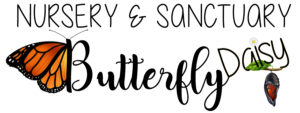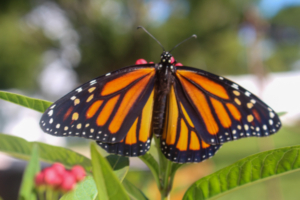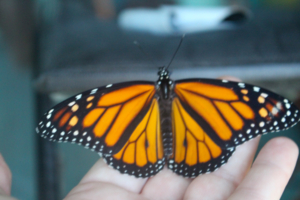Building a Butterfly Habitat
I know it may seem small and insignificant but it’s not about what it is, it’s about what it can become -Dr. Seuss
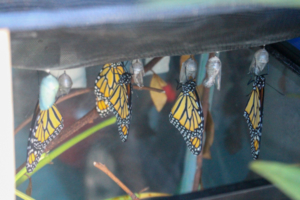
Did you know that fewer than 10% of monarch butterfly eggs actually turn into butterflies?! When the butterflies lay their eggs on milkweed leaves, other bugs will quickly eat the eggs or eat the tiny caterpillars when they hatch.
Building a butterfly habitat is actually quite simple; all you require is a thin breathable fabric and a simple container. Most materials can even be found around your home or they are very affordable online.
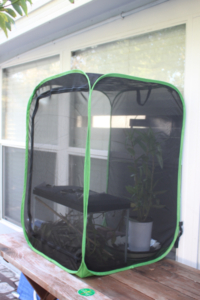 Once your habitat is built it’s pretty simple to start raising caterpillars. Currently, I have released over 100 Monarch butterflies, since November 13th, 2020, I started with an old aquarium and some screen as an enclosure. You can really make your habitat as fancy or simple as money and time allow. I quickly grew into a large enclosure then two and now I have a huge sanctuary.
Once your habitat is built it’s pretty simple to start raising caterpillars. Currently, I have released over 100 Monarch butterflies, since November 13th, 2020, I started with an old aquarium and some screen as an enclosure. You can really make your habitat as fancy or simple as money and time allow. I quickly grew into a large enclosure then two and now I have a huge sanctuary.
If you check your leaves about once a day you could find tiny little white eggs on the back of them. Cut off the part of the leaf that has the egg on it and place the leaf in a container; any container will do!
Be careful this will quickly become a full-time job if you collect too many eggs/caterpillars as they eat an insane amount of milkweed!
Making a Monarch butterfly enclosure!
You will need:
- Old lantern or box
- hot glue gun
- screening or sheer curtain
- milkweed
- paper towels
You probably already have a couple of these things around your house.
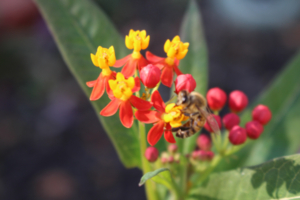
Milkweed is the only plant a monarch butterfly will lay her eggs on because it is the only plant the caterpillars can eat.
Some other great plans for attracting the monarchs are daisies, aster, lavender, and the butterfly bush.
Adding some butterfly-attracting plants will help bring even more butterflies to your backyard oasis.
Do I have you interested yet? After you’ve built your enclosure or you buy one, here’s what’s next:
- Get a small plastic container and start collecting eggs and caterpillars off your milkweed plant.
- Once the caterpillars hatch and start to grow a little larger put them in your enclosure. If you’re not careful, the big caterpillars will eat the leaves with the other eggs or tiny caterpillars on them. So it’s good to separate them once they get to a certain size.
- Clean, clean, clean! Clean out your caterpillar enclosure daily to avoid waste build-up. Place a fresh piece of milkweed on the paper towel at the bottom of the habitat and when it’s time to clean it out, gently slide a fresh leaf in. You will need to do this around three times a day.
- Once your tiny little caterpillars are done crunching and munching they usually go on a walkabout and sit somewhere to split their skin (it can take about a day). Then they come back down to eat again. When they go on their final walkabout they will look somewhere at the top of the cage to hang upside down and will look like little tiny J’s at the top of your enclosure. In the blink of an eye, they will split their skin and transform into their chrysalis. If you don’t spend your whole day watching it you’ll miss it because it only takes a couple of seconds.
- Now that your caterpillars have turned into their chrysalis all you have to do is wait and enjoy. Your little caterpillar will sit in his chrysalis for about 10-14 days. You will know he’s ready to emerge because his beautiful light green chrysalis will turn dark green, almost black. It’s translucent, and you will see the developing butterfly inside. They usually emerge early morning so keep an eye out because it’s another quick process of less than a minute. The fully formed Monarch will be out of the chrysalis, slowly moving its wings to dry them in preparation for flight.
- Once the butterflies have emerged and are ready to go, open the cage and watch the magical moment as they leave the enclosure! This will bring joy to everyone who sees it.
Milkweeds and Nectar Sources
Whether it’s a field, roadside area, open area, wet area, or urban garden; milkweed and flowering plants are needed for monarch habitat. Adult monarchs feed on the nectar of many flowers, but they breed only where milkweeds are found.
Importance of Milkweed
Many butterflies have a single plant required as a food source for their larval form called a host plant. Milkweed is the host plant for the monarch butterfly. Without milkweed, the larva would not be able to develop into a butterfly. Monarchs use a variety of milkweeds.
Different Types of Milkweed
Over 100 species of milkweed exist in North America, but only about one-fourth of them are known to be important host plants for monarch butterflies.
So Why Milkweed?
Protective Chemistry
Milkweed contains a variety of chemical compounds that make monarch caterpillars poisonous to potential predators. Milkweeds contain a cardiac (heart) poison that is poisonous to most vertebrates (animals with backbones) but does not hurt the monarch caterpillar. Some milkweed species have higher levels of these toxins than others. Monarchs show a preference for some milkweed species.
Protective Coloration
The adult monarch and monarch larvae are both brightly colored serving as a warning to potential predators that they are poisonous. Unsuspecting predators only need to taste a monarch butterfly or larva once to learn not to eat them again. Most animals quickly spit them out.
The Viceroy butterfly takes advantage of the protective coloration of the monarch butterfly by “mimicking”, or copying the colors and pattern of the monarch wing. With similar coloration, the viceroy can be mistaken for a monarch and is safe from these “educated” predators.
In Some Areas, Milkweeds are Considered to be Weeds
Milkweeds are listed in some states and provinces as noxious weeds. Certain milkweed species are considered noxious because they can be poisonous to cattle and other livestock. In some locations, it is difficult to improve habitat for monarch butterflies because of the status of milkweed. Eradication of milkweed is a threat to the monarch butterfly.
There are additional threats to monarch butterflies, such as the use of herbicides and pesticides.
A Few Bad Milkweeds
There are several native and introduced milkweed plants in the genus Cynanchum (swallow-worts) that are also eaten by monarchs. Swallow-worts have similar chemical properties to milkweeds in the genus Asclepias, that fool monarchs into laying eggs on them. Cynanchum species are not suitable food for monarch larvae. Caterpillars fail to develop into pupae when feeding on them. Please do not plant these milkweeds in your garden.
What’s the difference between noxious weeds and invasive plants?
Propagating Native Milkweeds for Restoring Monarch Butterfly Habitat
The number of monarch butterflies is rapidly declining. Milkweeds, which are the sole food source for monarch caterpillars, have also experienced a decline throughout the breeding range of this butterfly. Milkweeds can be grown from seeds or vegetatively from root cuttings or rhizomes
Nectar and Nectar Corridors
Adult monarchs feed on the nectar from flowers, which contain sugars and other nutrients. Unlike the larvae that only eat milkweeds, adult monarchs feed on a wide variety of nectar-bearing flowers. They will visit many different kinds of flowers in their search for food.
An abundance of nectar sources is especially important for migrating monarchs. Monarchs that are preparing to migrate south to Mexico need to consume enough nectar to build up fat reserves. The food they eat before and during their migration south must not only power them through the long journey but also must sustain them throughout the winter. Over-wintering monarchs feed very little or not at all. As monarchs migrate south, they will actually gain weight as they continue to feed on nectar-bearing flowers.
In eastern North America, the monarchs leave the over-wintering sites in the spring. Nectar is essential to making the journey to Texas. Nutrition from early spring nectar-bearing wildflowers provides the energy and nutrients for these monarchs to develop their reproductive organs. When they arrive in Texas, they will breed and then die. As the new monarchs emerge they will make their way north. It will take three more generations of monarchs to complete their journey northward and then start the migratory cycle once again.
Nectar corridors are a series of habitat patches containing plants that flower at the appropriate times during the spring and fall migrations. These patches provide stopping-off points for the migrating butterflies to refuel and continue their journey. Having these islands of nectar sources is particularly important within large areas of urban and agricultural development. The discontinuous patches of nectar sources are “corridors” that monarchs will follow, like stepping-stones across a stream to complete their migration.
